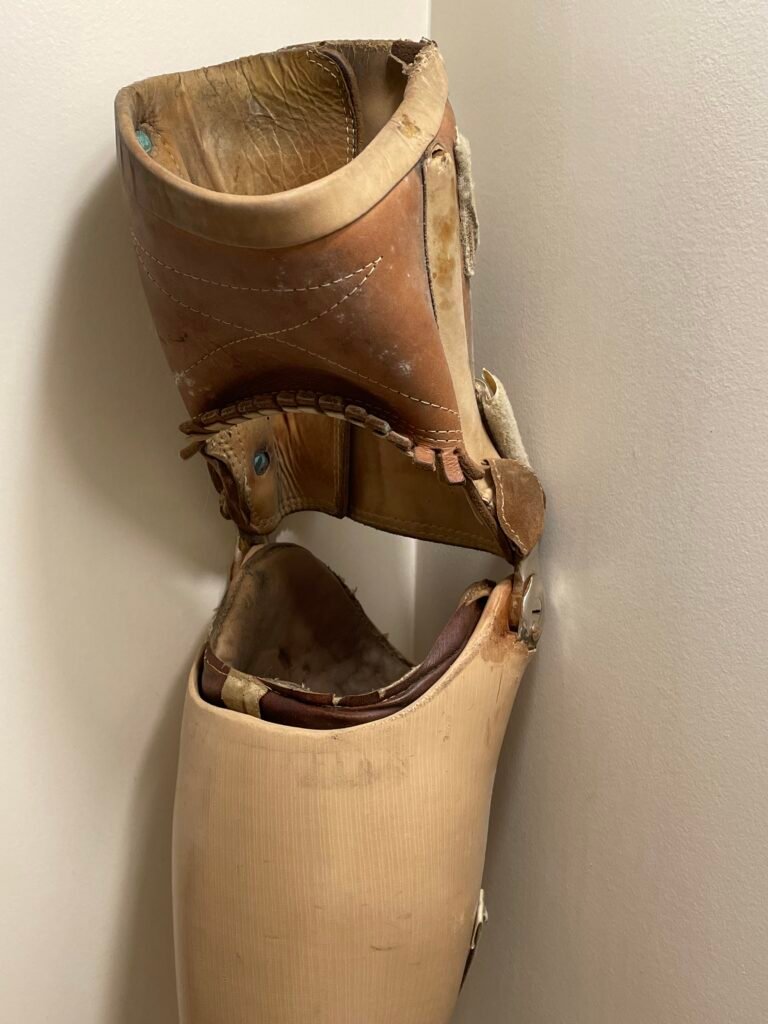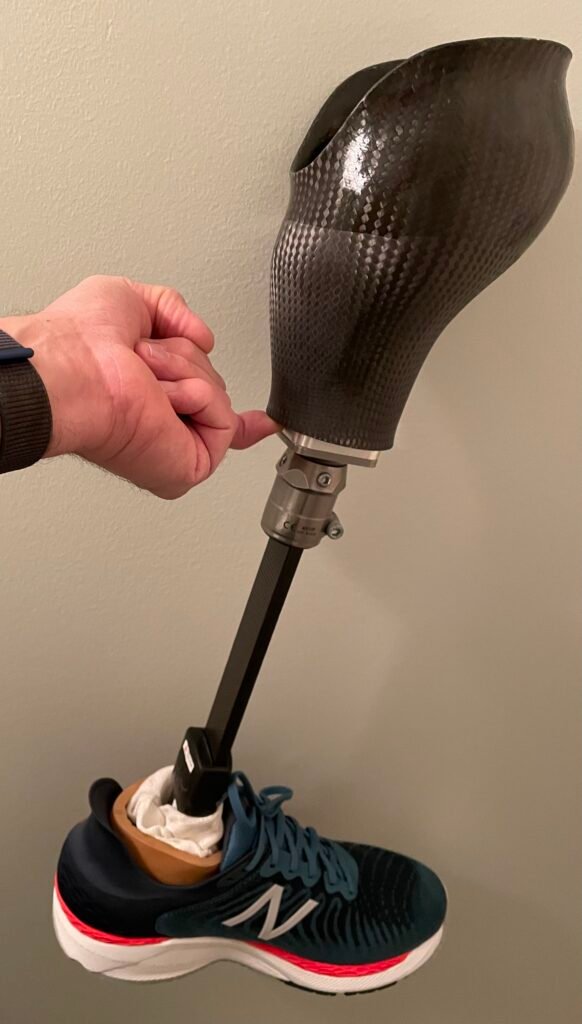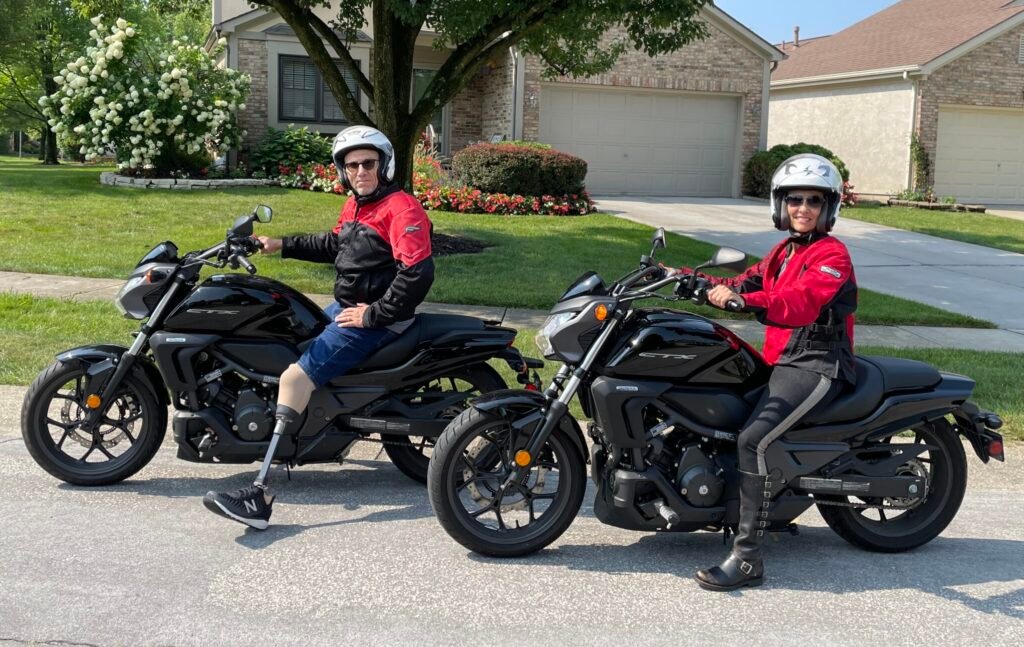In 1977, at age 17, I had a serious hit-and-run bike accident. I was airborne for over 50 feet, landed on my head without a helmet, and lost my left leg at my calf where I was hit. I was told I was lucky to be alive. At first, they tried to repair the damage ahead of gangrene. But ultimately, gangrene was winning the battle, and there were multiple amputations, with a final amputation that left me around 3 inches below the knee. The brain injury I sustained was a gradual one and was never addressed. Nonetheless, I had many stitches in the back of my head, double vision for months, and obviously one big concussion. I only remember waking up once in the ambulance and the next time in intensive care. After days in intensive care, I was told of the need for amputation. Then, I spent most of the summer in the hospital recovering as a resident, in rehab, and to get my first artificial leg. I am truly lucky to be alive, and it took me a year to feel near physical recovery. But the brain injury is another story. Please see my webspace: Brain Injury Help
After all the surgeries and medical stuff, I was directed to the hospital’s prosthetic facility in Fairfax, Virginia. It was then that I noticed the struggle they had with my case, and my 3” short residual. After several castings for a socket, and several trials for a prosthesis, I was sent home with this unimaginable prosthesis (see picture below). Since I had no clue what to expect, I tried to make it work. After six months, I could not make it work as it did not fit right, it was super bulky, had large metal hinges with a thigh corset, I could not even find pants to fit around it. I was minimally active and felt disabled. I had the accident after junior year in high school, where I was very active, played sports, and was academically strong. In any case, Fairfax Hospital is a big hospital with an outstanding reputation, where I had excellent medical care, but not as good of a prosthetic facility and no mention of a brain injury. Within 6 months of receiving my first prosthesis, I was looking for another facility, and after 4 additional months making a second prosthesis, the result was just as bad. It was heavy, had terrible fitting, was uncomfortable, and I could barely walk in it.
Looking back now, I understand I was a very hard case to work with because of my short residual. A year later, I had enough, and I was again in search for a better solution, as in a prosthesis that worked for me. After all, I was 18 by then and was eager to get my activity level back. Armed only with the mind of an engineer, the attitude of a problem solver, and a relentless energy, I started my search for a better prosthesis. I was in the library reading, no internet in 1978, and was inspired by several good readings about advances to help those with artificial limbs, including war veterans. So, I gathered my energy and decided to go look in bigger cities, starting with the Big Apple. Don’t ask me why New York City, I can say that it was an excuse to go there perhaps. Once I settled in NYC, I used the phone book, yes, the phone book, again it was 1978.
Starting at the top of the appropriate yellow pages section, I called a few places, explaining my case while asking questions. That’s when I hit gold. I found this small facility where the receptionist listened and understood what I was looking for. Then she transferred me to one of the owners, who was also an amputee, she said. After explaining my situation and what I was looking for, the man set me up with a quick appointment, and we met in his facility. During our meeting, he listened to me and examined what I was wearing. Then he shared with me that he was a WWII veteran with a similar short amputation, and started to explain the kind of transformation that we were about to go through building a completely different style prosthesis. I immediately felt relief and excitement at the same time, knowing that he would certainly understand my needs. During our visits, I was listening and cooperating, but my expectation was limited to something better than what I had. When it was time to start walking in a test prosthesis, I was very impressed, and when the leg was completed, and I tried it on, I was blown away. I thought, this is like the best artificial leg to have, especially as compared with the previous two, and it was. I remember having the desire to go dancing, literally. The fitting was near perfect, it walked well, it was slimmer, much lighter, and looked nice. We were having our final session before paying my $850 bill, yes, only $850 ($25,000 today). One thing that was special was how this man walked me through many important details about my situation, and educated me on what I should expect and look for in any prosthesis. This was a valuable lesson that helped my transformation through the years, and I continue to appreciate it to date. This prosthesis, and the lesson that came along with it, helped set me on a successful course. Although my prosthesis today has evolved in many ways, the essential core fitting concept remains the same, more on that later.
This was a wooden leg at the core, literally, covered with a paint shell, with primitive components and materials as compared to now. Especially the foot: it was wooden on the inside, with a cushioned heel, rubbery bottom, and pointy, flexible toes. However, this marked the beginning of real prosthetics for me, and from that point on, I knew how to move forward with prosthetics. This webspace is all about the end result of my prosthetics evolution and my success from this point to date, including customization for swimming and different activities, as well as configurations for old age. Yes, I am over 60 now, very active, and there are additional challenges that come with age. Anyways, it is important here to emphasize two things, first, socket and liner design as well as fitting are by far the most important part of making a prosthesis, especially for BK-Short, and this part is hardest to understand and make, even by the best prosthetist. Second, choosing a foot, assembling the socket to the foot, and alignment is the next important part. The good news is, there are several good feet available that suit BK-Short, and most prosthetists in my experience are capable of handling this part.


In summary, I was able to walk again with functional mobility, and relatively pain-free, mostly because of great fitting, good components, and good alignment. That prosthesis from 1978 was a game-changer, and as compared to the first two, all using the same common components and materials, good fitting and design of the socket and liner was the major difference. You can only imagine the advances and improvements in the last 45 years, especially when adding today’s components and materials— a mind-blowing difference (see picture above). It is important to note that while we watch on TV amputees with amazing abilities, no one understands that BK-Short are lucky just to be walking straight, let alone active and reasonably comfortable. The reason is obviously the residuals are too short to fit, leverage, operate, or maneuver a standard prosthesis, while carrying the body weight. Anyways, I am thankful to have been able to live an active lifestyle, including work, family, and other activities. I continue to ride my bicycle and motorcycle, work out at the gym, kayak and dive, do my own home improvement projects, work on my cars, etc. Now, I want to share all this through this webspace, in hopes of helping those like me with BK-Short, to achieve their optimum mobility, stay active and maintain reasonable comfort, so that they can achieve their own goals, just like I am.

